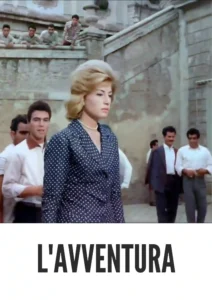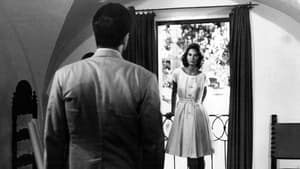Contact: info@alwanfilm.com
Video Sources 0 Views

Synopsis
The Enigmatic Journey of L’Avventura 1960 Colorized Review: A Colorized Cinematic Odyssey

Introduction
In the vast landscape of classic cinema, certain films stand out as landmarks of artistic achievement, and L’Avventura 1960 is undoubtedly one of them. Directed by the visionary Italian filmmaker Michelangelo Antonioni, this mesmerizing masterpiece defies easy categorization, blending elements of drama, mystery, and existential philosophy to create a haunting meditation on the human condition. Now, with the release of an early colored version, L’Avventura undergoes a vibrant transformation, inviting audiences to rediscover its beauty in a whole new light. In this comprehensive exploration, we delve into the significance of this colorized rendition, its impact on the cinematic landscape, and the enduring legacy of Antonioni’s magnum opus.
Check The Full Colorized Movies List
Check Our Colorized Movies Trailer Channel
Understanding L’Avventura 1960 Colorized: Director, Cast, and Genre
At the helm of L’Avventura 1960 is the visionary director Michelangelo Antonioni, whose unparalleled talent for visual storytelling has solidified his place in cinematic history. With a stellar cast including Monica Vitti, Gabriele Ferzetti, and Lea Massari, L’Avventura unfolds as a mesmerizing journey into the heart of human emotion, exploring themes of love, loss, and alienation with a depth and complexity that are as compelling today as they were upon the film’s release.
Antonioni’s direction infuses L’Avventura with a sense of mystery and ambiguity, as he invites viewers to ponder the enigmatic disappearance of a young woman named Anna during a yachting trip off the coast of Sicily. As the search for Anna unfolds, the film becomes a profound meditation on the nature of existence and the search for meaning in a world devoid of certainty.
Exploring the World of L’Avventura 1960 Colorized: Plot and Characters
Set against the backdrop of the stunning Italian landscape, L’Avventura 1960 follows the journey of a group of affluent socialites as they grapple with the sudden disappearance of their friend Anna. As the search for Anna leads them deeper into the heart of the Mediterranean, they find themselves drawn into a web of desire, jealousy, and existential angst that threatens to consume them.
At the center of the film is the enigmatic figure of Claudia, played with haunting intensity by Monica Vitti. As Claudia struggles to come to terms with Anna’s disappearance, she finds herself drawn to Sandro, Anna’s charismatic lover, portrayed with brooding complexity by Gabriele Ferzetti. Together, Claudia and Sandro embark on a journey of self-discovery that will forever alter the course of their lives.
The Art of Film Colorization
Film colorization is a process that involves adding color to black and white footage, thereby transforming the visual aesthetic of a film. While purists may argue that colorization alters the artistic integrity of the original work, proponents of the practice contend that it offers a fresh perspective on classic films, making them more accessible to modern audiences.
The early colored version of L’Avventura represents a bold new chapter in the film’s storied history, as it seeks to reimagine Antonioni’s masterpiece in vibrant hues and rich textures. By breathing new life into the film’s iconic imagery, colorization opens up a world of possibilities for audiences old and new, inviting them to experience L’Avventura in a whole new light.
Early Colored Films: A Brief History
The history of early colored films is a fascinating journey through the evolution of cinematic technology and artistic innovation. From the hand-tinted hues of silent-era classics to the vibrant palettes of early Technicolor productions, filmmakers have long experimented with color to enhance the visual impact of their work. As advances in technology have made colorization more accessible and sophisticated, filmmakers have embraced the opportunity to reimagine classic films in bold new ways.
L’Avventura joins a distinguished lineage of early colored films that have left an indelible mark on the history of cinema. From the lush landscapes of Gone with the Wind to the moody streets of Casablanca, early colored films have captivated audiences with their vivid imagery and timeless storytelling, paving the way for future generations of filmmakers to explore the boundless possibilities of color.
L’Avventura 1960 and Its Early Colored Version
The decision to release L’Avventura 1960 in a colorized format represents a bold new chapter in the film’s storied history. By adding color to Antonioni’s masterpiece, filmmakers seek to breathe new life into its iconic imagery and enhance its emotional resonance for modern audiences.
The early colored version of L’Avventura offers a fresh perspective on Antonioni’s timeless meditation on love, loss, and the human condition. By infusing the film’s evocative imagery with vibrant hues and rich textures, colorization invites audiences to experience L’Avventura in a whole new light, offering a visual feast for the senses that is sure to captivate viewers of all ages.
The Debate Over Film Colorization
The debate over film colorization is a contentious one, with passionate arguments on both sides of the aisle. While some view colorization as a valuable tool for preserving and reimagining classic films, others see it as a form of artistic sacrilege that diminishes the integrity of the original work. As the debate rages on, filmmakers and audiences alike are left to grapple with questions of authenticity, artistic intent, and the ever-shifting boundaries of cinematic innovation.
Examining L’Avventura 1960 as an Early Colored Film
Viewing L’Avventura 1960 in its early colored iteration offers a fresh perspective on Antonioni’s masterful exploration of love, loss, and the human condition. While purists may prefer the film’s original black and white aesthetic, the addition of color adds a new layer of visual richness and emotional depth to the viewing experience.
Influence and Legacy: L’Avventura 1960 Colorizeds Impact on Cinema
L’Avventura 1960 has left an indelible mark on the world of cinema, inspiring generations of filmmakers and reshaping the landscape of international cinema. Antonioni’s innovative approach to storytelling and visual composition has influenced filmmakers around the globe, leaving behind a legacy that continues to resonate with audiences to this day.
Antonioni’s Cinematic Legacy: Beyond L’Avventura 1960 Colorized
While L’Avventura 1960 stands as a crowning achievement in Antonioni’s illustrious career, its legacy is but a small part of his enduring impact on world cinema. From the existential ennui of La Notte to the haunting beauty of Blow-Up, Antonioni’s films continue to captivate audiences with their evocative imagery and profound insights into the human condition.
Themes Explored in L’Avventura 1960 Colorized
At its core, L’Avventura 1960 is a meditation on the fleeting nature of love, the elusiveness of happiness, and the existential angst that lies at the heart of the human experience. Through its haunting imagery and enigmatic narrative, the film explores themes of alienation, desire, and the search for meaning in a world devoid of certainty.
Reception and Controversy Surrounding L’Avventura 1960 Colorized
Upon its release, L’Avventura 1960 received widespread critical acclaim for its groundbreaking visual style and thought-provoking narrative. However, the decision to release the film in a colorized format sparked controversy among purists and scholars, reigniting the age-old debate over the preservation of cinematic heritage. Despite the initial backlash, the early colored version of L’Avventura found a new audience, introducing Antonioni’s timeless masterpiece to a new generation of viewers.
Where to Watch L’Avventura 1960 Colorized Online
For those eager to experience the vibrant transformation of L’Avventura 1960, the film is readily available on popular streaming platforms, ensuring that audiences old and new can immerse themselves in Antonioni’s cinematic masterpiece with ease.
FAQs About L’Avventura 1960 Colorized
For curious cinephiles seeking answers to burning questions about L’Avventura 1960, we’ve compiled a list of frequently asked questions to shed light on the film’s history, production, and enduring legacy.
Conclusion
In conclusion, L’Avventura 1960 stands as a timeless testament to the power of cinema to capture the complexities of the human experience. Whether viewed in its classic black and white form or its early colored iteration, Antonioni’s masterpiece continues to inspire and enthrall audiences around the world, reminding us of the enduring power of art to transcend time, space, and technology. As we reflect on the vibrant transformation of L’Avventura and the ongoing debate surrounding film colorization, let us celebrate the boundless creativity of filmmakers like Antonioni and the enduring beauty of one of cinema’s most beloved classics.

















